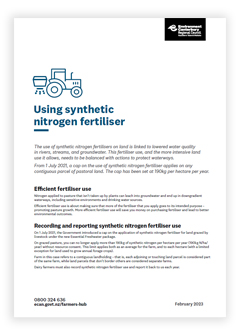Using fertiliser
The use of synthetic nitrogen fertilisers on land is linked to lowered water quality in rivers, streams, and groundwater. This fertiliser use, and the more intensive land use it allows, needs to be balanced with actions to protect waterways.
There is an application limit of 190kg per hectare per year of synthetic nitrogen fertiliser on any contiguous parcel of pastoral land.
Using fertiliser efficiently
Nitrogen applied to pasture that isn't taken up by plants can leach into groundwater and end up in downgradient waterways, including sensitive environments and drinking water sources.
Efficient fertiliser use is about making sure that more of the fertiliser that you apply goes to its intended purpose – promoting pasture growth.
More efficient fertiliser use will save you money on purchasing fertiliser and lead to better environmental outcomes.
- The industry-agreed Good Management Practices for nutrient management and irrigation and water use are the first steps in making sure you're using fertiliser efficiently.
- A report into reducing nitrogen loss we commissioned has come up with four industry-supported actions for further reducing nitrogen leaching.
- Making more efficient use of fertiliser or farm effluent through fertigation or effluent injection can help reduce the need for synthetic fertiliser use.
Where the synthetic nitrogen fertiliser use limit applies
A cap on the application of synthetic nitrogen fertiliser for land grazed by livestock came into effect in July 2021.
On grazed pasture, you can no longer apply more than 190kg of synthetic nitrogen per hectare per year (190kg N/ha/year) without resource consent. This limit applies both as an average for the farm*, and to each hectare (with a limited exception for land used to grow annual forage crops).
Dairy farmers must also record synthetic nitrogen fertiliser use and report it back to us each year.
*Farm in this case refers to a contiguous landholding – that is, each adjoining or touching land parcel is considered part of the same farm, while land parcels that don’t border others are considered separate farms.
The cap on synthetic nitrogen fertiliser use only applies to pastoral land – that is, land on which livestock is grazed. This does not include the grazing of the stubble of a crop that has been harvested after arable land use.
On land with mixed use, the 190kg N/ha/year limit applies when the land is being used for the grazing of livestock, from crop or pasture preparation until grazing finishes.
It's important you measure your synthetic nitrogen use to ensure it is below 190kg N/ha/year. You can use our calculator (XLSX file, 103 KB) to determine this, and if required, review your farming practices to reduce your use.
Dairy farmers: How to report your synthetic nitrogen fertiliser use
Dairy farmers are required to report their annual synthetic nitrogen fertiliser use to us. This report is to cover the period from 1 July–30 June and is to be submitted by 31 July each year.
To submit your report, you can use one of three platforms:
- The National Online Reporting Tool. For help using this tool, please refer to these videos.
- The MyBallance programme. Ballance fertiliser users should be familiar with this reporting system, but you don't need to be a Ballance customer to use their tools. Visit the Ballance website for more information.
- The HawkEye programme. HawkEye is Ravensdown's fertiliser use reporting system. Contact HawkEye customer support on 0800 73 73 73 for more information on how to use the programme.
What information you'll need to report
Contact information
- Full name
- Contact phone number
- Email address
Farm information
- New Zealand Business Number (NZBN)
- Farm name
- Dairy supply number
- Dairy company name
- Total farm area (in hectares)
- Total effective area (area farmed, in hectares)
- Geospatial boundary (Add a geospatial shape file of boundary. Depending on how your data is submitted you may be able to select the geospatial area on a map.)
- Receipts for fertiliser purchases:
- supplier's name
- date of purchase
- item description
- item unit purchased (kg)
- Dairy effluent consent number (you can find this using our consent search tool)
Information for each *farm
- Name / label (give a name or number for each land parcel)
- Total area in hectares (If you have only one contiguous land holding, this will be the same as total farm area; if you have more than one contiguous land holding, the sum of total areas should be the same as the total farm area.)
- Geospatial boundary
- Grazed land area (in hectares)
- Grazed forage crop area (in hectares)
- Grazed non-forage land area (in hectares)
- Ungrazed land area (in hectares)
*Farm in this case refers to a contiguous landholding – that is, each adjoining or touching land parcel is considered part of the same farm, while land parcels that don’t border others are considered separate farms.
Synthetic nitrogen cap calculation
- Reporting year (e.g. 2022)
The following four can be calculated using the Ballance or HawkEye tools, or our Excel calculator (XLSX file, 102.5).
- Grazed land nitrogen application rate
- Grazed forage crop application rate
- Grazed non-forage crop application rate
- Ungrazed land application rate
- Confirmation that less than 190kg of synthetic nitrogen fertiliser per hectare has been applied to grazed pasture
Fertiliser application
- Fertiliser name and manufacturer
- Day of application
- Percentage of nitrogen in fertiliser
More information
In October 2021, the Ministry for the Environment published several nitrogen cap guidance documents, covering the different types of farming operations. You can also contact your fertiliser supplier for more advice on measuring and meeting the nitrogen cap. If you cannot meet the 190kg N/ha/year cap (at both property and hectare level), you will need to apply for resource consent.
For help with using the synthetic nitrogen reporting tool, the developers have released a series of tutorial videos.

